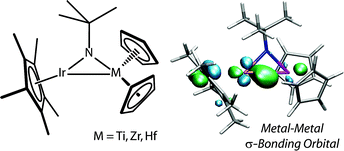Treatment of Cp*Ir NtBu (1) with the appropriate metallocene equivalent is an effective route for the preparation of the heterobimetallic complexes Cp*Ir(μ-NtBu)MCp2 (2-M, M = Ti, Zr, Hf). The electronic structures of the isostructural series of compounds, 2-M, are described with reference to single-crystal X-ray, Raman, UV-vis, and cyclic voltammetry data. Density functional theory (DFT) calculations were used to aid in the interpretation of this experimental work. Treatment of the zirconium or hafnium congeners with 2,6-lutidinium triflate leads to protonation of the Ir–M bond, to afford Cp*Ir(μ-NtBu)(μ-H)MCp2OTf (3-M, M = Zr, Hf). Compound 3-Zr was characterized by single-crystal X-ray diffraction and independently prepared by the reaction of 1 and Cp2Zr(H)Cl in the presence of Me3SiOTf. In reactions analogous to those for 2-Zr, 2-Hf reacts with S8 and aryl azides to insert an S-atom or aryl azide fragment into the metal–metal bond, yielding Cp*Ir(μ-NtBu)(μ-S)HfCp2 (6-Hf) and Cp*Ir(μ-NtBu)(N3Ph)HfCp2 (4-Hf), respectively. Heating 4-Hf results in N2extrusion to form Cp*Ir(μ-NtBu)(NPh)HfCp2 (5-Hf). The kinetics of the latter reaction were studied to obtain activation parameters and a Hammett trend; these data are compared to those for the analogous reaction involving Ir–Zr heterobimetallics.

